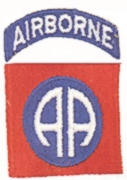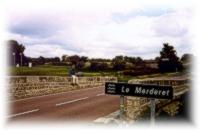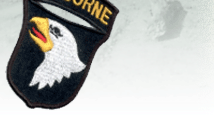The battle around La Fière Bridge
 When the main Airborne force landed around midnight Robert Murphy's job as a pathfinder was done. He had marked the way for the others and now he stayed behind on the dropzone and helped gathering the supply-bundles that had landed with the paratroopers. At first light, which must have been around eight or eight-thirty Murphy's platoonleader 1st Lt. Lightchester (commander of the 1st Pathfinder Bn.) told him to go look for Lt. John J (Red Dog) Dolan. Lt. Dolan was the commander of A Co. at that time. This company's goal was to take and hold the La Fière Bridge. When the main Airborne force landed around midnight Robert Murphy's job as a pathfinder was done. He had marked the way for the others and now he stayed behind on the dropzone and helped gathering the supply-bundles that had landed with the paratroopers. At first light, which must have been around eight or eight-thirty Murphy's platoonleader 1st Lt. Lightchester (commander of the 1st Pathfinder Bn.) told him to go look for Lt. John J (Red Dog) Dolan. Lt. Dolan was the commander of A Co. at that time. This company's goal was to take and hold the La Fière Bridge.
The La Fiere bridge is located just west of Ste. Mere d'Eglise, the primary target of the 82nd Airborne Division. The bridge runs across the small river the Merderet. Holding the bridge ment holding the western entrance of ste. Mere d'Eglise.
This city was so important because it was the crossing of the road from Carentan to Cherbourg and the road running from the west side of the peninsula to the beach that was code-named Utah Beach. If the Germans wanted to launch a full scale counterattack on the men coming in on the beaches from the sea, then they certainly had to bypass ste. Mere d'Eglise at La Fière Bridge. A large German counterattack in the first hours of the invasion could endanger the whole operation.
 When
Murphy arrived at the bridge, a defense-line had already been established.
The paratroopers had pulled a German truck onto the bridge, to prevent
any vehicles from passing. Anti-tank mines were laid in front of the truck
to add to the roadblock. When
Murphy arrived at the bridge, a defense-line had already been established.
The paratroopers had pulled a German truck onto the bridge, to prevent
any vehicles from passing. Anti-tank mines were laid in front of the truck
to add to the roadblock.
The Germans had flooded the grasslands, prior to the invasion and the road alone was the sticking out above the water, because it was on a dike. Parachutes and supply-bundles could be see floating in the water and it was obvious that paratroopers had drowned in these fields on landing. The paratroopers had no choice then to dig in on the sides of the road, and even their they could dig very deep without getting water in their foxholes.
The artillery support that the defenders had was only one 57mm canon that had been flown in by glider.
Murphy was not the only soldier joining the men from A Co. at that time. A group of soldiers from the 508th had been trapped in Coccagny during the night and had now gotten away and pulled back across the bridge.
Just as the men from the 508th had crossed the bridge, German 88th' s were zeroing in on the bridge. These shells were particularly feared by the Americans because you couldn't hear them coming in. Mortar shells and rockets also started to land within the American defense-line.
Three German tanks advanced towards the bridge as soon as the shelling had stopped. It were French Renault tanks which the Germans had captured during their drive into France in 1940. Although not very modern they still posed a serious threat for the weakly armed Airborne soldiers. The infantry followed the tanks in their advance, using the tanks as cover.
 Two
American bazooka-teams jumped up as soon as the tanks got within range.
Each team had two men, one aimer and one loader. John D Boldison and Gordon
Poya made the first team and Leonard Peterson, a Swedish airborne soldier
that barely spoke English and Marcus Huyme made the second team. The aimers
had to stand-up in their foxholes when they fired their bazooka's. This
ment that they had to expose themselves to all enemy fire. The didn't
pay attention to the German fire and placed several hits on the first
two tanks, disabling both. The third tank also received some damage, but
it managed to pull back. Two
American bazooka-teams jumped up as soon as the tanks got within range.
Each team had two men, one aimer and one loader. John D Boldison and Gordon
Poya made the first team and Leonard Peterson, a Swedish airborne soldier
that barely spoke English and Marcus Huyme made the second team. The aimers
had to stand-up in their foxholes when they fired their bazooka's. This
ment that they had to expose themselves to all enemy fire. The didn't
pay attention to the German fire and placed several hits on the first
two tanks, disabling both. The third tank also received some damage, but
it managed to pull back.
A German officer climbed out of the first tank, in an attempt to run off to safety. There was not much feeling of compassion with the Germans among the Airborne soldiers and several men opened fire on the officer as soon as he had lifted himself from on the turret. The officer was killed at the spot.
The Infantry also remained at a distance once they had lost the support of their tanks. The battle was still far from being over. More critical hours were still ahead of A Co. of the 505th Parachute Infantry Regiment. Relief came in the night of June 8th. The 325th Glider Infantry Regiment of the same 82nd Airborne division took the positions at the bridge over from A Co. By that time more canons had been brought in for the paratroopers. For Robert Murphy the relief ment the end of his activities in Normandy. He had been hit by shrapnel in his back as a result from the continuous German shelling. He was taken back to England where he spend several weeks in a hospital.
Veterans recall d-day
Art Hopper, Glider pilot 434th TCG
Mike McKinney 16th Reg. Co. L. 1st Div. First ones in on Omaha.
Clifford D. Krantz, C-47 pilot 441st TCG
Victor Miller 5th Ranger Bat., Omaha Beach, Dog Green, 0730
Lt. Marvin Litke, Pilot in the 71st Sqn. of the 434th Troop Carrier Group
Joe Manzella, Omaha Beach 3rd Wave
Robert Murphy, 505th Reg.
Howard Hoye Rifleman 505th PIR 82nd Airborne Division
Ralph Fancher and Lester Leonard McLean , 618th
Ammunition Co., 74th Ordinance Bat., 6th Eng. Special Brigade
Terrell L Noffsing, Copilot on a C-47
Dick Wolch 82nd Airborne Division 508th PIR 3rd Bat. Co. G
1st Lt. McKennan 101st Airborne Division
Gerry Paulk 501 PIR 101st Airborne Division 2nd Bat Co. D.
© normandy44
<< BACK HOME
Read about the 82nd Airborne division during the Holland drop here...
|

 When the main Airborne force landed around midnight Robert Murphy's job as a pathfinder was done. He had marked the way for the others and now he stayed behind on the dropzone and helped gathering the supply-bundles that had landed with the paratroopers. At first light, which must have been around eight or eight-thirty Murphy's platoonleader 1st Lt. Lightchester (commander of the 1st Pathfinder Bn.) told him to go look for Lt. John J (Red Dog) Dolan. Lt. Dolan was the commander of A Co. at that time. This company's goal was to take and hold the La Fière Bridge.
When the main Airborne force landed around midnight Robert Murphy's job as a pathfinder was done. He had marked the way for the others and now he stayed behind on the dropzone and helped gathering the supply-bundles that had landed with the paratroopers. At first light, which must have been around eight or eight-thirty Murphy's platoonleader 1st Lt. Lightchester (commander of the 1st Pathfinder Bn.) told him to go look for Lt. John J (Red Dog) Dolan. Lt. Dolan was the commander of A Co. at that time. This company's goal was to take and hold the La Fière Bridge.
 When
Murphy arrived at the bridge, a defense-line had already been established.
The paratroopers had pulled a German truck onto the bridge, to prevent
any vehicles from passing. Anti-tank mines were laid in front of the truck
to add to the roadblock.
When
Murphy arrived at the bridge, a defense-line had already been established.
The paratroopers had pulled a German truck onto the bridge, to prevent
any vehicles from passing. Anti-tank mines were laid in front of the truck
to add to the roadblock.
 Two
American bazooka-teams jumped up as soon as the tanks got within range.
Each team had two men, one aimer and one loader. John D Boldison and Gordon
Poya made the first team and Leonard Peterson, a Swedish airborne soldier
that barely spoke English and Marcus Huyme made the second team. The aimers
had to stand-up in their foxholes when they fired their bazooka's. This
ment that they had to expose themselves to all enemy fire. The didn't
pay attention to the German fire and placed several hits on the first
two tanks, disabling both. The third tank also received some damage, but
it managed to pull back.
Two
American bazooka-teams jumped up as soon as the tanks got within range.
Each team had two men, one aimer and one loader. John D Boldison and Gordon
Poya made the first team and Leonard Peterson, a Swedish airborne soldier
that barely spoke English and Marcus Huyme made the second team. The aimers
had to stand-up in their foxholes when they fired their bazooka's. This
ment that they had to expose themselves to all enemy fire. The didn't
pay attention to the German fire and placed several hits on the first
two tanks, disabling both. The third tank also received some damage, but
it managed to pull back.